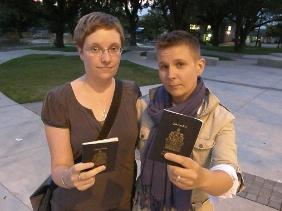East Vancouver residents Karen-Marie Perry and Andrina Perry have been together since early 2005 and have been married since 2008. They share a surname and live together. So when they travel to the United States, Andrina generally completes one customs form for the two of them, as most families do.
But during a recent visit, the couple had to fill out two separate customs forms because they are not considered a family in the United States.
The form says: “Each arriving traveler or responsible family member must provide the following information (only one written declaration per family is required).”
As the couple was approaching US customs at Vancouver international Airport on July 28, a Canadian official approached them, asking if they lived together and how they were related. The couple indicated they were married. The Canadian official then said the couple was required to fill out two forms and couldn’t go through US customs together.
“I was very angry,” Karen-Marie says. She was so shaken that she couldn’t even fill out the customs form; Andrina completed it. Karen-Marie even considered abandoning the trip.
When the couple reached the US customs officials, they didn’t attempt to confirm the policy.
“The majority of customs officers are quite intimidating,” Andrina says. “I figured we might never get there.”
Rachel Torres, spokeswoman for US Customs and Border Protection, says US law prohibits same-sex couples from filling out a form as a family. Under the 1996 Defense of Marriage Act, any federal laws that refer to marriage recognize only unions between one man and one woman, she says.
Immigration Equality, which fights for equal treatment under US immigration law for lesbian, gay, bisexual, transgender and HIV-positive individuals, has been pushing the Obama administration to allow same-sex couples to fill out one form, says executive director Rachel Tiven.
“Every Canadian I know is offended by the United States’ refusal to recognize couples who are Canadian-married couples,” Tiven says.
She says the Defense of Marriage Act shouldn’t apply to a form that refers to a “family.” And, she says, it’s inefficient for officials to split up families when processing customs papers.
Tiven says she’s heard cases of same-sex couples filling out one form and other cases in which they had to fill out separate forms. But she says it’s unclear if the policy itself has changed over the years.
The organization has received several complaints about the policy, but the Perrys’ case is the first she’s heard of in which a Canadian official told a couple to fill out separate US customs forms.
“It certainly isn’t the Canadian officials’ job to do the dirty work for the Americans,” she says.
Unlike the US customs form, the Canadian form doesn’t require cohabitating people to be related or married to fill it out together. Instead, it says, “You may list up to four people living at the same address on one card.”
A Canadian same-sex couple who won the right to marry in Ontario in 2002 also faced a surprise the following year at the US border when they had to fill out separate customs forms. Kevin Bourassa and Joe Varnell refused to do so and were denied entry, according to their blog.
“This is a case of the United States in essence telling the Canadian government which Canadians qualify as families and which Canadians do not,” they wrote. The couple did not return phone calls or emails.
The Canadian official who approached the Perrys was quite sympathetic and said the US policy has changed so often that it’s hard for Canadian officials to keep track of the procedures, Andrina notes.
Before this trip, the couple had travelled to the United States twice and filled out one US customs form.
“They’re constantly flip-flopping back and forth,” Karen-Marie says. “Is there some sort of alert system for queer communities so we can prepare ourselves for when we’re considered a family and when we’re not?”
Andrina says the experience has made her less likely to travel to the United States.
“It’s one more thing on top of all of the additional security measures and screenings and things that just make you question if it’s even worth it anymore,” she says. “And we want to be somewhere where we feel safe and can be a family.”

 Why you can trust Xtra
Why you can trust Xtra


